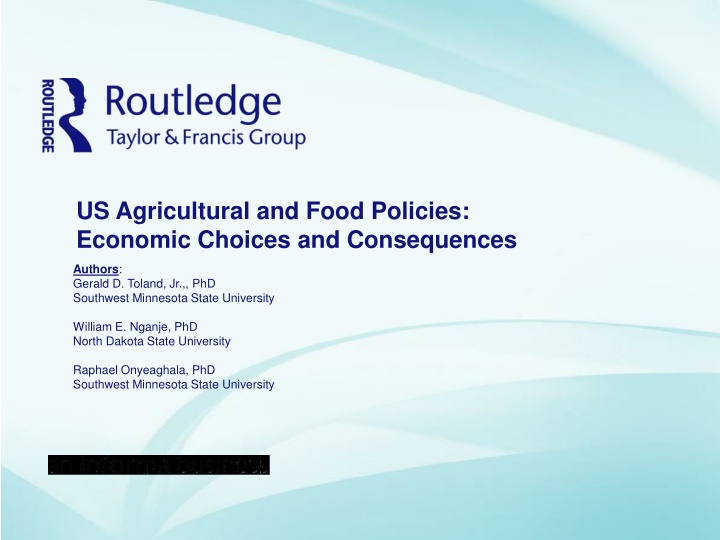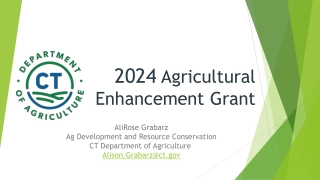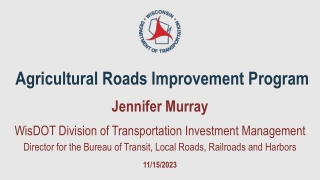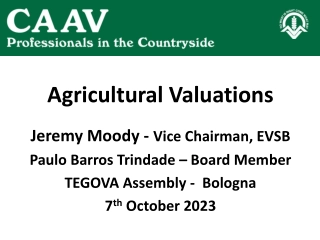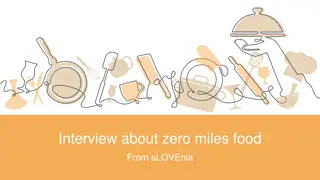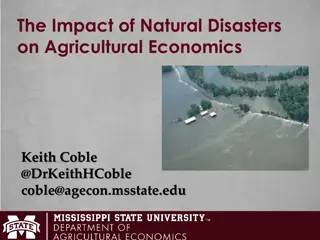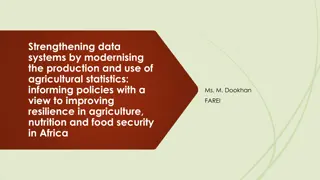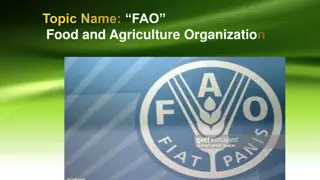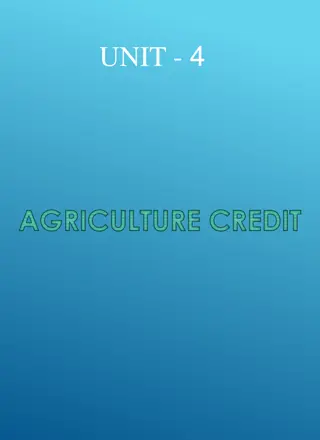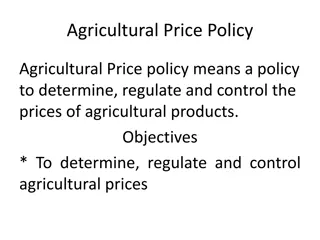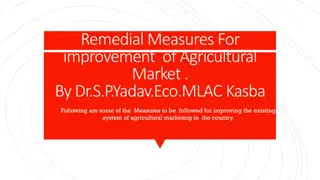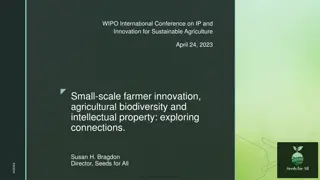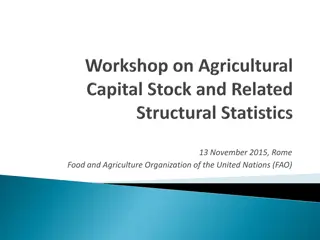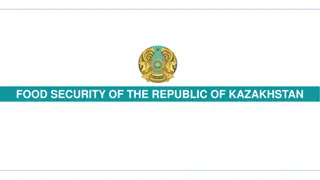US Agricultural and Food Policies: Economic Choices and Consequences
This book delves into the economic factors shaping the US agri-food system, exploring demographic trends, changing consumer attitudes, policies for inclusivity, organic farming, and the importance of agricultural education in the 21st century.
Download Presentation

Please find below an Image/Link to download the presentation.
The content on the website is provided AS IS for your information and personal use only. It may not be sold, licensed, or shared on other websites without obtaining consent from the author.If you encounter any issues during the download, it is possible that the publisher has removed the file from their server.
You are allowed to download the files provided on this website for personal or commercial use, subject to the condition that they are used lawfully. All files are the property of their respective owners.
The content on the website is provided AS IS for your information and personal use only. It may not be sold, licensed, or shared on other websites without obtaining consent from the author.
E N D
Presentation Transcript
US Agricultural and Food Policies: Economic Choices and Consequences Authors: Gerald D. Toland, Jr.,, PhD Southwest Minnesota State University William E. Nganje, PhD North Dakota State University Raphael Onyeaghala, PhD Southwest Minnesota State University
US Agricultural and Food Policies: Economic Choices and Consequences Chapter 12 Current Developments and New Dynamics Influencing Agricultural and Food Policy Chapter Twelve Objectives Summary of Chapter Twelve: Notable demographic trends and changing consumer attitudes are affecting the socio-economic character of the US Agri-Food system. Chapter 12 focuses on key features associated with these dynamics. We initially review considerations that are broader in scope, and then concentrate on topics of special interest. The sequence of topics is: We analyze economic factors influencing the growing potential for new entrants to participate in the US agri-food system, including women, socially disadvantaged groups and veterans. (Continued on next slide) 2
US Agricultural and Food Policies: Economic Choices and Consequences Chapter 12 - Current Developments and New Dynamics Influencing Agricultural and Food Policy Chapter Twelve Objectives (Continued) We evaluate policies and programs that aim to facilitate new roles in the US agri-food system for women, socially-disadvantaged groups and veterans. We investigate the wide-ranging socioeconomic effects of changing consumer attitudes about food sources, and the associated influence of the local foods movement. We study the increasing prevalence of organic farming in the US, and the ongoing developments in the marketing patterns for organics, as well as for foods with related endorsements or claims. We emphasize the vital functions of agricultural and food education in the 21st-Century. 3
US Agricultural and Food Policies: Economic Choices and Consequences Chapter 12 - Current Developments and New Dynamics Influencing Agricultural and Food Policy Economic Structure of US Agriculture: Established Trends and New Developments Technology adoption, specialization and US government policies continue to favor large-scale family farms. Rational consolidations and economies-of-scale are powerful economic forces tending to increase average farm size and reduce farm numbers. What new influences are affecting the structure of US agriculture? On the supply side: Women, Veterans and Socially-Disadvantaged groups are actively seeking entry as competitors in US agriculture. On the demand side: Local food movements among modern, affluent and socially-energized US consumers create market niches that new entrants can fill. Before further exploration of new dynamics, let s examine current data. 4
US Agricultural and Food Policies: Economic Choices and Consequences Chapter 12 - Current Developments and New Dynamics Influencing Agricultural and Food Policy New and established influences affecting the structure of US agriculture (Continued) Status of US Farms in 2014, based on the Ag Census: Total number: 2,084,000; and Total Farm Acres: 913 million Average Acres per US farm: 438.1 acres/farm Snapshot of US Farm Market Structure in 2014: Small US Farms: Gross Cash Farm Income (GCFI) < $350,000/year 90% of total US Farm Numbers; 21.9% of total value of US farm production Controlled 46% of all US farmland Mid-Sized and Large Farms: Mid-sized have $350,000 GFCI $1 Million/year; Large Farms have GFCI > $1 Million/year. ~ 10% of total US Farm Numbers; More than 68% of US total farm value. 5
US Agricultural and Food Policies: Economic Choices and Consequences Chapter 12 - Current Developments and New Dynamics Influencing Agricultural and Food Policy New and established influences affecting the structure of US agriculture (Continued) Based on 2014 Ag Market Structure, Medium-to-Large farms dominate the market value produced the industry. New trend: Census data reveal an increased number of small crop farms since the year 2000. Strengths and Limitations of Small-Scale Farm Operations Opportunities for smaller new entrants to agricultural markets Entrepreneurial nimbleness : Redirecting production for a small sized operation can sometimes occur more rapidly than large-scale farms. Diversification to reduce risk: Compared to larger farms, small scale operations may have increased options to diversify their product offerings to meet new market demands, while reducing the market risk associated with the production of any one single product. 6
US Agricultural and Food Policies: Economic Choices and Consequences Chapter 12 - Current Developments and New Dynamics Influencing Agricultural and Food Policy Strengths and Limitations of Small-Scale Farm Operations (Continued) Limitations for smaller new entrants to agricultural markets New technologies may be better suited to larger scale farms because up- front investment costs are spread across more acres and/or increased output. Smaller farms may have more difficulty demonstrating credit-worthiness, or may have less capacity to absorb downside financial risk. Some tax-deductible advantages and commodity program benefits may favor larger-sized operations relative to smaller ones. Recent trends in smaller-sized farm operations include: New and beginning farms often enter markets as small-scale operations. Revitalize US agriculture: Entry of younger and more-diverse owner- operators. 7
US Agricultural and Food Policies: Economic Choices and Consequences Chapter 12 - Current Developments and New Dynamics Influencing Agricultural and Food Policy Recent trends in smaller-sized farm operations (Continued) If women, socially disadvantaged groups and veterans are to become new participants in US agriculture, they are more likely to be small-scale start-up businesses serving local markets. Diversification for small-scale farms includes active pursuit of off- farm income. Farm start-ups can gain cost efficiencies and market access as participants in farmers markets and cooperative food hubs. Agricultural markets and local communities often benefit from new entrants and heightened competition: Creates increased consumer choice, and suppliers improve quality and service to remain viable Entry of small farm operators associated with volunteerism and rural development 8
US Agricultural and Food Policies: Economic Choices and Consequences Chapter 12 - Current Developments and New Dynamics Influencing Agricultural and Food Policy Growing Role of Women Farm Operators in US Agriculture 1982: Women at 12.2 percent of US farm operators (1st, 2nd or 3rd). 2012: Ag Census reports that 30.5 percent of all US farm operators are female (969,672 in number). The data show a 150% in the role of women operators in production agriculture during a thirty year period (1982-2012). Similar statistic: 12.7% of farms in 2012 managed by women as the principal (1st) operators, compared to 5.4% in 1982. Commodities Marketed by US Principal Women Farm Operators in 2012 Measurement: Annual $Value of Sales by Commodity Group ($VSCG) 9
US Agricultural and Food Policies: Economic Choices and Consequences Chapter 12 - Current Developments and New Dynamics Influencing Agricultural and Food Policy Commodities Marketed by US Principal Women Farm Operators in 2012 (Continued) Measured by ($VSCG) Principle Women Operators accounted for $12.897 Billion (about 3.3% of $VSCG on all farms) in 2012. Highest-valued $VSCG for women principal farmers include: Poultry and Eggs, Cattle and Calves, and the combined grouping of Grains, Oilseeds, Dry Beans and Dry Peas. These categories comprised 56.9% of the women principal operator $VSCG total. Identify production for principal women operators earning $VSCG $100,000/year; and 60.9% of all women principal operator $VSCG: Milk from Cows, Cotton and Cottonseed, Aquaculture, Poultry and Eggs, Grains Oilseeds, Dry Beans and Dry Peas; Nursery, Greenhouse, Floriculture, and Sod 10
US Agricultural and Food Policies: Economic Choices and Consequences Chapter 12 - Current Developments and New Dynamics Influencing Agricultural and Food Policy Contributions of Underserved Minority Operators in US Agriculture Minority US farm operators increased by an average of 15 percent between the between 2007 Ag Census and 2012 Ag Census. The largest percent changes occurred within the Asian (+22.2%) and Hispanic (+20.6%) categories. 2012 Census of Ag: Eight percent of all principle operators were minorities, compared to 7 percent in the 2007 Ag Census. Increased ethnic diversity creates new niches and sources of comparative advantage to enhance US agriculture s global competitiveness. 11
US Agricultural and Food Policies: Economic Choices and Consequences Chapter 12 - Current Developments and New Dynamics Influencing Agricultural and Food Policy Incentives for Socially Disadvantaged Groups to Participate in US Farm Bill Programs USDA s NRCS offers programs that provide support and technical services for socially disadvantaged farmers and/or ranchers. Definition: A Socially Disadvantaged Farmer/Rancher (SDF/R) is any farmer or rancher subjected to racial or ethnic prejudices because of their identity as a member of a group without regard to their individual qualities. Included SDF/R groups are African Americans, American Indians or Alaskan natives, Hispanics, and Asians or Pacific Islanders. The Outreach and Assistance to Socially Disadvantaged Farmers and Ranchers (OASDFR) program was authorized in the 1990 Farm Bill, Section 2501. Today, OASDFR is known as the 2501 Program. 12
US Agricultural and Food Policies: Economic Choices and Consequences Chapter 12 - Current Developments and New Dynamics Influencing Agricultural and Food Policy Outreach and Assistance to Socially Disadvantaged Farmers and Ranchers (OASDFR) Program [the 2501 Program ] (Continued) The 2501 Program requires the USDA to engage in outreach activities and technical assistance that facilitate the entry of disadvantaged groups into farm markets as viable businesses. 2501 is implemented via grants managed by land grant universities, tribal governments, Latino-serving institutions, veterans groups, state- controlled institutions, community-based organizations and nonprofits. Office of Outreach and Advocacy (OOA) helps socially disadvantaged groups and veterans access specially-designed benefits, including NRCS conservation programs, Farm Service Agency (FSA) financial assistance programs, Sustainable Agriculture and Research and Education (SARE) programs, and programs offered through state government departments of agriculture. 13
US Agricultural and Food Policies: Economic Choices and Consequences Chapter 12 - Current Developments and New Dynamics Influencing Agricultural and Food Policy Expanding Role of Local Food Markets Strong 21st-Century trend: US consumers seeking out marketing channels offering locally-produced foods. Total US annual local food sales rose from $4.8 billion in 2008 to and $6.1 billion in 2012, a 6.2% annual growth rate. Approximately 164,000 farmers (8% of all US farms) marketed local foods to account for 1.5% of total US agricultural sales in 2012. What is a Local Food Market? Section 6015 of the 2008 Farm Bill defines local : products transported less than 400 miles or within the state in which they are produced. Definition partly determines a producer seligibility to participate in USDA s Business and Industry loan program. 14
US Agricultural and Food Policies: Economic Choices and Consequences Chapter 12 - Current Developments and New Dynamics Influencing Agricultural and Food Policy Variety of farm operations and/or market connections can be classified as part of a local food system: Community and school gardens Farm-to-school programs Community-Supported Agriculture (CSA)* and related direct-to- consumer marketing arrangements Farmers markets, roadside farm stands, pick-your-own operations Food hubs, market aggregators, community kitchens Food cooperatives and buying clubs On-farm sales/stores and Agri-tourism *In a CSA, local groups agree to be shareholders or subscribers who financially support the production costs of a farm or community garden in exchange for receiving shares of the farm s output during the growing season. 15
US Agricultural and Food Policies: Economic Choices and Consequences Chapter 12 - Current Developments and New Dynamics Influencing Agricultural and Food Policy Federal Policies Facilitating Local Food System Development Farmers Market Promotion Program (FMPP): A 2014 Farm Bill competitive grant program that expands opportunities and increases funding for direct farm-to-consumer projects. Local Food Marketing Promotion Program (LFPP): A 2014 Farm Bill competitive grant program that opens-up USDA support for intermediary supply chain enterprises who coordinate a distribution network to deliver local or regional foods. Most farm bill programs are not generally intended to provide a farm- safety-net exclusively to assist any particular set of US farms. Broadly-applicable USDA programs include: Marketing/promotion, business assistance & ag-research, rural & community development, nutrition and education, and conservation. 16
US Agricultural and Food Policies: Economic Choices and Consequences Chapter 12 - Current Developments and New Dynamics Influencing Agricultural and Food Policy Effects of Organic, Sustainable and Related Certifications on US Food Markets Organic Production and Local Food Systems The 2007 Agricultural Resource Management Survey (ARMS) data on 21,669 surveyed organic farms determined that 45.7% (9,896) were engaged in direct marketing of their products to consumers. In 1997, direct-to-consumer markets and natural foods stores were typical organic outlets. By 2008, nearly half of all organic foods were distributed by traditional retail market intermediaries (supermarkets, big-box stores, etc.). 17
US Agricultural and Food Policies: Economic Choices and Consequences Chapter 12 - Current Developments and New Dynamics Influencing Agricultural and Food Policy Importance of the National Organic Program (NOP) The NOP is a verifiable national system for organic certification. It establishes a set of both prohibited and permitted substances associated with organic production and handling operations. NOP Certification process is rigorous and credible. The certified organic label improves consumer trust dramatically. NOP set the stage for the significant growth of organic product markets. Marketing success of organics in the US agri-food system attracted a variety of endorsements and claims. Examples include: free-range, antibiotic free, cage-free, hormone free, grass-fed, natural. The rigor and evidence standing behind these other labels is variable. 18
US Agricultural and Food Policies: Economic Choices and Consequences Chapter 12 - Current Developments and New Dynamics Influencing Agricultural and Food Policy What is Sustainability in the US Agri-Food System? Producers and consumers express interest in producing foods sustainably Currently, there is no certification process for Sustainably Produced that is similar to the rigor of the Organic label. Much time and effort would be required, but a credible sustainable endorsement would be possible, because guidelines are available. The 1990 Farm Bill, U.S. Code Title 7, Section 3103 included a Sustainable Agriculture Definition (See next slide) 19
US Agricultural and Food Policies: Economic Choices and Consequences Chapter 12 - Current Developments and New Dynamics Influencing Agricultural and Food Policy 1990 Farm Bill s Sustainable Agriculture Definition (Continued) Sustainable agricultureis an integrated system of plant and animal production practices having a site-specific application that will over the long-term: satisfy human food and fiber needs; enhance environmental quality and the natural resource base upon which the agriculture economy depends; make the most efficient use of nonrenewable resources and on- farm resources and integrate, where appropriate, natural biological cycles and controls; sustain the economic viability of farm operations; and enhance the quality of life for farmers and society as a whole. 20
US Agricultural and Food Policies: Economic Choices and Consequences Chapter 12 - Current Developments and New Dynamics Influencing Agricultural and Food Policy Ongoing Development of Sustainable Food Production Practices USDA s National Institute of Food and Agriculture (NIFA) oversees funding for the Sustainable Agriculture Research and Education (SARE) program. SARE's charge is to jointly improve producer profitability, environmental conditions, and social justice through grants, research and education. SARE is administratively guided by volunteer administrative councils in each of four US Regions (Western, Southern, North Central and North East). 21
US Agricultural and Food Policies: Economic Choices and Consequences Chapter 12 - Current Developments and New Dynamics Influencing Agricultural and Food Policy The Importance of Agricultural Literacy Example: Many US consumers cannot distinguish the terms organic and sustainable . Achieving agricultural literacy in US society is challenging, but a very necessary goal. Intentional efforts are required if US food consumers are to learn fact-based knowledge about food production, safety and nutrition. USDA s National Institute of Food and Agriculture (NIFA) cooperates with state governments to produce the Agriculture in the Classroom (AITC) curriculum for use in US primary and secondary school systems. AITC has rigorous academic foundations. AITC defines Agricultural Literacy as: having the ability to understand and communicate the source and value of agriculture as it affects our quality of life. 22
US Agricultural and Food Policies: Economic Choices and Consequences Chapter 12 - Current Developments and New Dynamics Influencing Agricultural and Food Policy The Importance of Agricultural Literacy (Continued) The AITC Curriculum utilizes the National Agricultural Literacy Outcomes (NALO s) to track students in mastering agricultural knowledge. NALO s determine benchmarks for progress in agricultural literacy throughout all K-12 educational levels. NALO s are broken down into major areas of academic achievement: Agriculture and the Environment Outcomes Plants and Animals for Food, Fiber & Energy Food, Health, and Lifestyle Science, Technology, Engineering & Math (STEM) Culture, Society, Economy & Geography 23
US Agricultural and Food Policies: Economic Choices and Consequences Chapter 12 - Current Developments and New Dynamics Influencing Agricultural and Food Policy The Importance of Agricultural Literacy (Continued) Beyond federal and state government efforts, volunteer organizations are also making sizable contributions to agricultural literacy The National Association of Agricultural Educators (NAAE) is a voluntary federation of state agricultural educators associations with more than 7,800 members. NAAE is involved in school-based agricultural education at all levels, from middle school through postsecondary, and state and national agricultural education leaders. Future Farmers of America (FFA) and 4-H programs are also very important in agricultural education efforts. More work lies ahead to increase US agricultural literacy. 24
